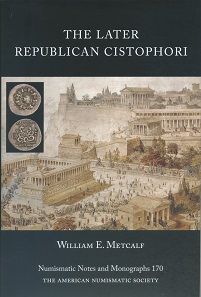Written by Ursula Kampmann
Translated by Leonie Schulze
July 19, 2018 – The cistophori are some of the most exciting denominations of the Roman Empire as they represent the pragmatism that Roman invaders applied in taking over, adjusting and using the infrastructure of the conquered territories. Although they were first introduced as a common currency in the Attalid kingdom, cistophori continued to be struck for another 200 years. One time period that is particularly interesting in this context is the Late Republic as it was around that time that the Roman proconsuls of the provinces were depicted on the reverse of these coins alongside the municipal officials in charge. William Metcalf addresses precisely this time period between T. Ampius (governor of the Asia province 58-57) and Q. Metellus Scipio (governor of the province 49).
William E. Metcalf, The Later Republican Cistophori. Numismatic Notes and Monographs 170. The American Numismatic Society, New York 2017. 87 pp. und 86 b/w plates. Hardcover. 16 x 23,5 cm. ISBN: 978-0-89722-347-8. US$ 75 + shipping or 55 GBP.
William (Bill) Metcalf is by no means a stranger to those who are interested in cistophori. In 1980 already, he wrote a fundamental study about Hadrian’s cistophori and he has since then continued to publish both longer and shorter works on this topic. It comes as no surprise that he maintained a close relationship with Charles Hersh. The collector and expert of Republican coinages had himself begun work on a catalog of the Late Republican cistophori, which was incorporated in Metcalf’s publication.
It is a straightforward book that has to be purchased by all those who want to classify coins on a scholarly level. Following a short introduction on Roman governors and Greek authorities, you will find its centerpiece: the catalog. As mentioned before, it is a die study.
Arranged according to mints – only Ephesus, Pergamum, Tralles, Apameia and Laodicea were still minting at the time of the Roman Republic – the die combinations are listed. Every town is followed by a short commentary.
How straightforward this book really is, is demonstrated by the fact that William Metcalf summarizes his findings on merely two and a half pages. Without a single footnote! That does not imply that his findings are less noteworthy. He postulates that the actual minting of cistophori ends with these Late Republican cistophori, and the 38 specimens issued by Mark Antony are representative of a completely new currency, which is referred to as cistophori anachronistically. According to Metcalf, an extensive emission depicting an ATPA monogram is both the culmination and endpoint of the cistophori coinage of Asia Minor.
Three appendices – weight and fineness, names and orthography, hoards – and outstanding indices introduce the main part of this book, as well as 86(!) plates.
And that is it. William Metcalf wrote exactly what was necessary to understand the material. Nothing more, but also not too little.
You can order your copy directly from the ANS website.
European readers might prefer ordering the book from the British store Oxbow.




